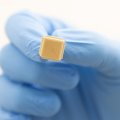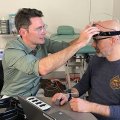Up to 90,000 Australian Diggers who helped win World War II are now missing in Cyberspace, thanks to errors in the government-sponsored online memorial known as the World War 2 Nominal Roll (note: figure 2 in name is correct).
The database (http://www.ww2roll.gov.au/) established by the former Liberal Government in 2002, has more holes than Swiss cheese, says University of Queensland journalism masters graduate Bill Park.
“It is not a reliable source of information about many soldiers of WWII from Queensland,” said Mr Park. “The situation in other States is apparently much the same.”
Mr Park completed three years’ detailed work researching his Master of Philosophy thesis which examined the World War 2 Nominal Roll and how reliable it is.
The degree was awarded and now the thesis has been published internationally by a German firm.
Mr Park will give a free public lecture on this topic hosted by the University’s School of Journalism and Communication on Thursday, April 22 at 2.30pm to 4.45pm, followed by a reception at the conference room, level 1, Duhig Library, Building #2, UQ St Lucia campus (RSVP Joan Burnett, 3346 8294, j.burnett@uq.edu.au).
Bill has also just been named as the UQ School of Journalism and Communication’s Distinguished Alumnus for 2010. Ironically his efforts have not met with much recognition from the Australian Government.
But he’s not giving up because he has another very personal interest: Bill Park turns 90 this year and he himself served as a lieutenant in New Guinea in the Army in World War II. Now he and his Digger mates want to make sure the Roll is accurate and up-to-date.
There are many omissions, errors and inconsistencies in the entries on the Roll, says Bill, mostly among the so-called ‘Choco Soldiers’. Yet it was many of these ‘Choco Soldiers’ who helped defeat the Japanese advance along the Kokoda Track, at Salamaua, at Milne Bay and on Bougainville.
Mr Park notes that since the launch of the Roll in November 2002, successive Governments and their bureaucracies have become aware of deficiencies in the listings but have shown a distinct lack of enthusiasm to remedy them.
“Yet over the same time frame they have spent millions of dollars on Remembrance campaigns involving phrases such as ‘Lest we forget’ and ‘We will remember them’ and more millions each year on recruiting campaigns.
“How can we remember them, if we can’t find out about them?” Mr Park asks in his thesis.
“There is intense public interest in seeking out ancestors both civilian and military –including from the Boer War and World I as well as WWII and afterwards.
“How can we expect to be able to recruit service men and women in the future if we don’t fulfill our promises to remember our past warriors?
“If the way the WW2NR is managed and displayed is public evidence of how well the nation honours its pledges, we don’t do it very well.
“The WW2NR can be fixed – it must be fixed if we are serious about honouring our pledges. It is in our interests to do so. If we can’t be bothered honouring our past pledges, why should anyone trust us to honour future pledges?”
Media:
Bill Park, M.Phil, B.Comm, 07 33797316 wapark@powerup.com.au
Dr John Cokley, 07 3365 3381
Some case histories: just the tip of an iceberg
1. George Herbert Williams, QP 185 – permanent army. A Boer War veteran, served in WWI, between the wars and was in the permanent army in WWII. Captain and QuarterMaster of 15th Battalion (CMF) in 1940-41. Died in hospital, 10 August 1941. No record on WW2NR.
2. Allan Donald Q18800 enlisted in the CMF in June 1941. He apparently absconded in July but was later found and brought back to his unit (15th Battalion). However, he developed pneumonia and 3 weeks later died at the Military Hospital at Kangaroo Point in Brisbane. No record on the WW2NR.
3. Henry Charles Walsh Q33489 enlisted in the CMF 1941. He was in camp with the 31st Battalion at the Military Camp Show grounds, Townsville, in March that year when he died, cause of death being asphyxia and epileptic fit due to epilepsy. No record on the WW2NR.
4. Stephen John Keane was a Captain in the 51st Battalion in Cairns in camp in March 1941. He died in the Cairns Hospital on 13 April 1941, cause of death stated as myocardial failure and acute bursitis. There is no record on the WW2NR. Most of his file is ‘missing’ but there is on the National Archives of Australia website a file for Q39028 which contains the Crown Solicitor’s Opinion on a service and compensation claim by his widow. The Crown Solicitor concluded that ‘he died from disease which was contracted on war service’ and that the Commonwealth was liable to make provision of his widow and family under the Defence Act 1903-1941. A year or so I was contacted by his grandson wondering why he could not find any reference to his grandfather on the WW2NR.
5. Paul Moni recorded on the WW2NR for service he didn’t have with the RAAF, but not recorded for a month’s service with the militia in November 1941-January 1942. Missing from Roll.
6. Wilfred D Radford. Promoted to lieutenant of 49th Battalion Signals Platoon in 1938 – tried to enlist in the AIF in 1939 but rejected due to asthma. Remained in the militia until early 1941 when he resigned. No record of any service on WW2NR.
.jpg)









